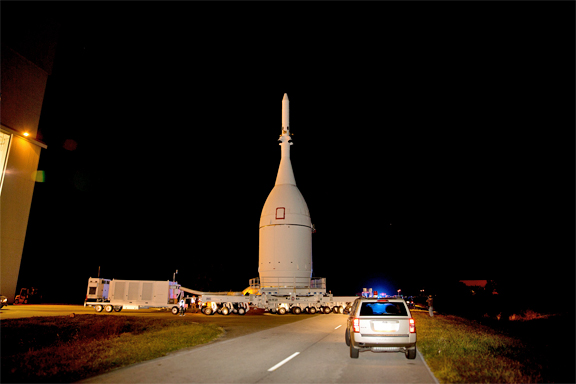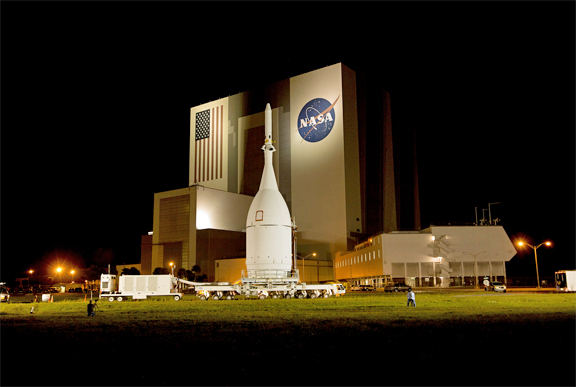
[SatNews] The Lockheed Martin [NYSE: LMT] built Orion spacecraft has completed its 22-mile, 6-hour journey from the Launch Abort System Facility...
at Kennedy Space Center, to launch pad 37 at Cape Canaveral Air Force Station, Florida—Orion is now another step closer to its first test flight on December 4, 2014.

The Orion spacecraft's rollout at Cape Canaveral, enroute to the launch pad.
“This spacecraft is going to push the boundaries of scientific discovery and human achievement,” said Michael Hawes, Lockheed Martin Orion program manager. “One day, not too far in the future, an astronaut will leave the first footprints in the red dust of Mars, and we’ll look back and say that journey started here.”
This morning, the 50,000 lb. spacecraft was lifted about 200 feet up and mated to the United Launch Alliance (ULA) Delta IV Heavy rocket, which Lockheed Martin contracted for the flight. Over the next few weeks, the rocket and spacecraft will be integrated and powered up, and engineers will test and verify interfaces between the two in preparation for Exploration Flight Test-1 (EFT-1).

“It has been a tremendous team effort with all of our mission partners to get us to this point just one month prior to launch,” said Jim England, ULA’s EFT-1 program manager. “We are honored to play such a critical role in this important launch for NASA and are focused on providing mission success so that Orion can complete all of its mission objectives.”
During EFT-1, the uncrewed spacecraft will travel 3,600 miles beyond Earth—15 times further than the International Space Station. That same day, Orion will return to Earth at a speed of approximately 20,000 mph for a splashdown in the Pacific Ocean. EFT-1 will provide engineers with data about systems critical to crew safety, such as heat shield performance, separation events, avionics and software performance, attitude control and guidance, parachute deployment, and recovery operations to validate designs of the spacecraft before it begins carrying humans to new destinations in deep space.
The Lockheed Martin infosite is located at http://www.lmco.com/

